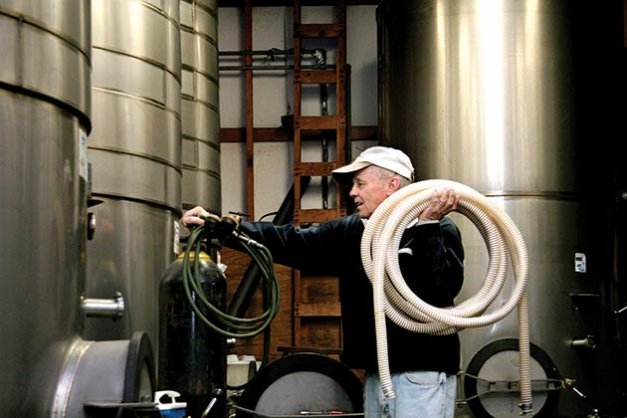
Randy Tucker expanded the number of wines sold at Tucker Cellars from two to 15 and sells much of his wine to other wineries. Photo by Melissa Hansen
Third-generation wine grape grower Randy Tucker has made wine in Washington’s Yakima Valley for 30 years. Through the decades, he’s changed business plans at Tucker Cellars to fine-tune the winery’s market niche, but he’s now facing one of the biggest changes as he approaches retirement.
Randy’s grandparents Melvin and Vera Tucker moved from Nebraska after the Depression to the Yakima Valley, where they sharecropped wine and table grapes from 1933 to 1946 for Sunnyside’s wine grape pioneer William Bridgman. Melvin obtained cuttings from Bridgman and planted European varieties under contract with Bridgman.
Historical artifacts, photos, and even an empty Upland Winery bottle of Muscatel adorn the wall of the winery tasting room in Sunnyside. One of the contracts signed by Bridgman dates to 1937, and a framed bill of lading shows that in 1939, Melvin brought in 101,942 pounds of grapes (Semillon, Zinfandel, Malvoisie, and Norton/Brighton) to Upland Winery and received $764. His 61,490 pounds of Muscat grapes fetched $538.04.
Randy’s father Dean planted more vinifera grapes in 1978 and added a produce stand in 1979. Tucker Cellars opened its doors in 1981, one of the first wineries to be established in Yakima Valley.
That same year, Randy returned to the family’s new winery, leaving his grocery store marketing job on the west side of the state. He took winemaking classes at the University of California, Davis, and worked alongside winemaking consultants Stan Clarke and Kay Simon for two years before taking the reins as winemaker in 1983.
At first, Tucker Cellars made only two wines, Chenin Blanc and Johannisberg Riesling. Today, it produces 15 different kinds of wine, but it’s in custom winemaking where Randy has developed the winery’s niche.
In the early 1980s, though he added more varietal wines to the mix and changed the label several times, the winery still struggled to match sales to production.
“I could see that we were going to be in a sea of wine if we couldn’t figure out how to sell what we were making,” Randy said.
In 1984, he began making wine for wholesale customers, sending bulk or bottled wine to wineries in Minnesota, Missouri, Michigan, and other states.
These days, he makes wine for about 40 customers, including wineries in the Pacific Northwest. Some want the wine bottled as “shiners,” an industry term for wine bottles without labels; others want wine in bulk to blend and bottle themselves.
The original family vineyard of 35 acres was sold several years ago, along with Randy’s own vineyard of about 15 acres, although he continues to purchase the grapes for his wines. “They’re the same grapes that we’ve always been using, I just can’t put ‘estate’ on the label anymore,” he explained.
Many of the original vines planted in the vineyard were varieties that have fallen out of favor, such as Chenin Blanc, and have been replaced with more popular cultivars like Viognier and Syrah.
Changes
During the last three decades, Randy has watched phenomenal growth occur in the industry.
“The piece of the pie is getting much smaller,” he said, but adds that Tucker Cellars is still doing well with its wholesale wine niche. “A lot of wineries look down on what’s called a ‘virtual winery’, but you still have to produce quality wine other wineries believe is good enough to put their label on.”
Tucker Cellars, located on the edge of Sunnyside along a major interstate, also relies on tourism to bring in customers and has a case-buyers wine club to help move product.
One of the biggest technological changes he’s made in winemaking is in the use of oak barrels. French oak barrels are expensive, costing more than $950 for something used for a limited time. Wine oxidizes as it is stored in the barrels, another negative factor with barrels.
Randy first experimented with toasted oak chips in 2007, and used oak chips in a tank of Viognier wine, much like making a cup of tea. The oak chips were put in a muslin bag and steeped in the wine for about a month.
“The wine won best of show at an Olympia wine competition, and I’ve never looked back,” he said, adding that many of his wines are now made with oak chips.
Today, Randy and his wife, Debbie, who has helped run Tucker Cellars, now face their biggest change.
With no children interested in taking over the winery, the Tuckers have developed an exit strategy; the winery is for sale. “It’s time to move on,” he said, adding that it’s been a great industry to work in. “I’ve been blessed to go to work for the last 32 years and love what I do.” •






Leave A Comment